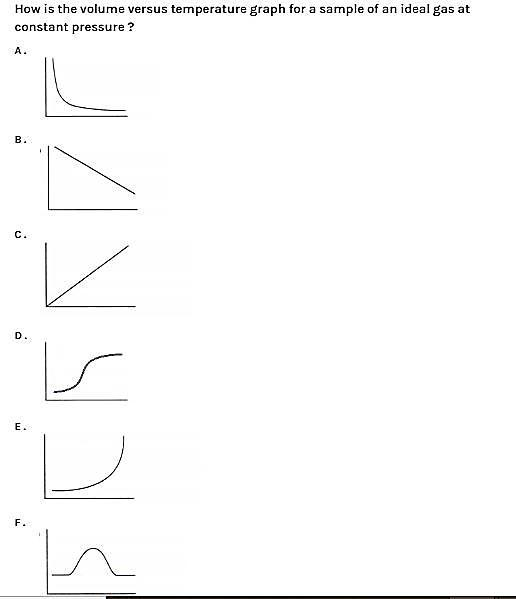
How is the volume versus temperature graph for a sample of an ideal gas at constant pressure?

Answer
216.3k+ views
Hint: To answer this question, we should know about the relationship between volume and temperature. This relationship was given by Charles’ law. By using this law we can easily find out the answer.
Complete step by step answer:
> To answer this question, we should know about Charles’ law. We should know that Charles’ law is one of the gas laws which explain the relationship between volume and temperature of a gas. Charles’s law states that when pressure is held constant, the volume of a fixed amount of dry gas is directly proportional to its absolute temperature. It should be noted that, when we take two measurements in direct proportion then any change made in one of them affects the other through direct variation. Charles’ Law is expressed by the equation:
\[\begin{align}
& V\alpha T \\
& \dfrac{V1}{T1}=\dfrac{V2}{T2} \\
\end{align}\]
> From the above expression we should know that V1 and V2 are the Initial Volumes and Final Volume respectively. T1 refers to the Initial Temperature and T2 refers to the Final Temperature.
> We can understand this by taking one example, we should know that on heating up a fixed mass of gas, that is, increasing the temperature, the volume also increases. Similarly, on cooling, the volume of the gas decreases.
So, from this we can now say that option C is correct. In this graph we can say that it is a straight line because volume and temperature are directly proportional.
Note: It is important to discuss that the unit Kelvin is preferred for solving problems related to Charles Law, and not Celsius. Kelvin (T) is also known as the Absolute temperature scale. We should know about Charles' law application in real life. It has a wide range of applications. Helium balloons shrink in a cold environment. Second example is this : while jogging in winters, we face difficulty because our lung capacity decreases.
Complete step by step answer:
> To answer this question, we should know about Charles’ law. We should know that Charles’ law is one of the gas laws which explain the relationship between volume and temperature of a gas. Charles’s law states that when pressure is held constant, the volume of a fixed amount of dry gas is directly proportional to its absolute temperature. It should be noted that, when we take two measurements in direct proportion then any change made in one of them affects the other through direct variation. Charles’ Law is expressed by the equation:
\[\begin{align}
& V\alpha T \\
& \dfrac{V1}{T1}=\dfrac{V2}{T2} \\
\end{align}\]
> From the above expression we should know that V1 and V2 are the Initial Volumes and Final Volume respectively. T1 refers to the Initial Temperature and T2 refers to the Final Temperature.
> We can understand this by taking one example, we should know that on heating up a fixed mass of gas, that is, increasing the temperature, the volume also increases. Similarly, on cooling, the volume of the gas decreases.
So, from this we can now say that option C is correct. In this graph we can say that it is a straight line because volume and temperature are directly proportional.
Note: It is important to discuss that the unit Kelvin is preferred for solving problems related to Charles Law, and not Celsius. Kelvin (T) is also known as the Absolute temperature scale. We should know about Charles' law application in real life. It has a wide range of applications. Helium balloons shrink in a cold environment. Second example is this : while jogging in winters, we face difficulty because our lung capacity decreases.
Recently Updated Pages
Alpha Particle Scattering and Rutherford Model Explained

Angle of Deviation in Prism: Formula, Explanation & Diagram

Angular Momentum of a Rotating Body: Definition & Formula

Apparent Frequency Explained: Formula, Uses & Examples

Applications of Echo in Daily Life and Science

Average and RMS Value Explained: Formulas & Examples

Trending doubts
JEE Main Correction Window 2026 Session 1 Dates Announced - Edit Form Details, Dates and Link

Atomic Structure: Definition, Models, and Examples

Alpha, Beta, and Gamma Decay Explained for JEE & NEET

Understanding Electromagnetic Waves and Their Importance

Geostationary and Geosynchronous Satellites Explained

Inertial and Non-Inertial Frame of Reference Explained

Other Pages
NCERT Solutions for Class 11 Chemistry Chapter Chapter 6 Equilibrium

Clemmensen and Wolff Kishner Reductions Explained for JEE & NEET

Organic Chemistry Some Basic Principles And Techniques Class 11 Chemistry Chapter 8 CBSE Notes - 2025-26

JEE Main 2023 January 29th Shift 2 Physics Question Paper with Answer Keys and Solutions

Current Loop as a Magnetic Dipole: Concept, Derivation, and Examples

NCERT Solutions For Class 11 Chemistry Chapter 1 Some Basic Concepts of Chemistry in Hindi - 2025-26




